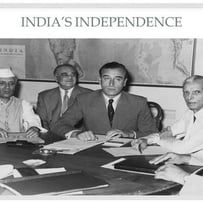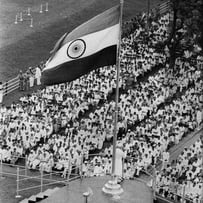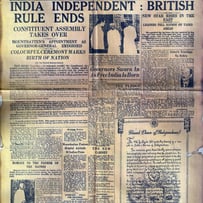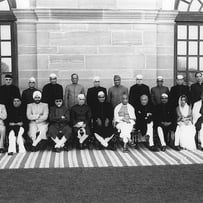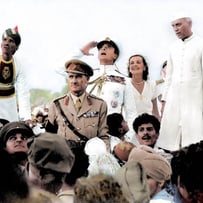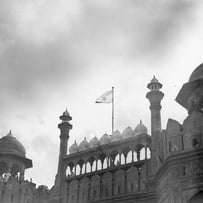India Gains Independence: August 15, 1947 – The Birth of a Nation
After centuries of colonial rule, India breaks its chains and rises as a sovereign republic
GOAT NEWS
Hindvarta Desk
6/9/20253 min read
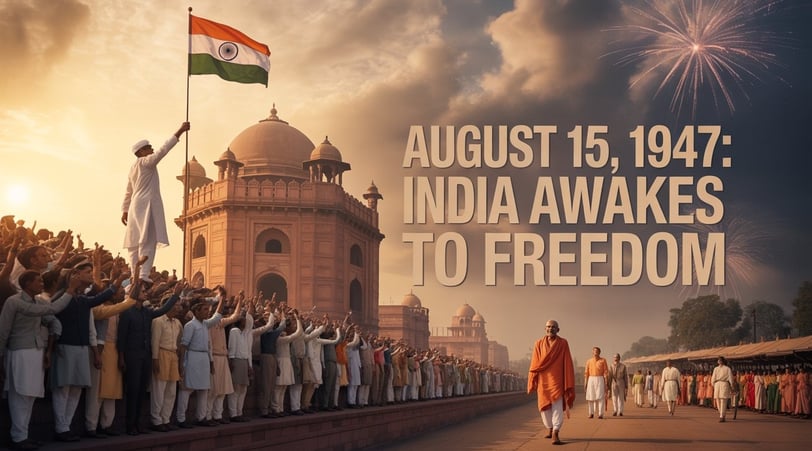

A New Dawn After Centuries of Struggle
At the stroke of midnight on August 15, 1947, India awoke to freedom. After nearly 200 years of British colonial rule, the Indian subcontinent finally emerged as an independent nation. The Indian tricolor was hoisted for the first time above the Red Fort in Delhi, and Pandit Jawaharlal Nehru, the country’s first Prime Minister, addressed a newly awakened nation with his historic speech:
“At the stroke of the midnight hour, when the world sleeps, India will awake to life and freedom.”
This was not just the birth of a nation—it was the realization of a dream nurtured by millions, paid for by decades of sacrifice, suffering, and nonviolent resistance.
🇬🇧 The End of British Raj
The British East India Company had first set foot in India in 1600. Over time, its influence expanded and was formalized into Crown rule after the Revolt of 1857. For nearly a century thereafter, Indians lived under the British Raj, a regime marked by economic exploitation, political suppression, and growing resistance.
By the early 20th century, a mass movement for independence had emerged—led by stalwarts like:
Mahatma Gandhi – who championed Satyagraha (nonviolent resistance)
Jawaharlal Nehru, Sardar Vallabhbhai Patel, Subhas Chandra Bose, and B.R. Ambedkar
Countless unsung heroes, martyrs, farmers, workers, and students who filled the streets and jails in defiance
Mass Movements That Changed History
India’s freedom struggle was multi-dimensional, with movements that spanned generations:
Non-Cooperation Movement (1920)
Civil Disobedience Movement (1930) and the Salt March
Quit India Movement (1942) – demanding “British Quit India”
Revolutionary activities by Bhagat Singh, Chandrashekhar Azad, and others
Armed resistance by Subhas Chandra Bose's Indian National Army
The Second World War weakened British control and increased pressure for withdrawal. With growing international support, internal revolt, and the Labour government in Britain eager to end imperial costs, the stage was set for a final transfer of power.
Partition – A Nation Divided
India's independence came with an unforgettable cost: the Partition of India. On August 14–15, 1947, India was divided into two nations—India and Pakistan—based largely on religious lines.
The Partition unleashed:
One of the largest mass migrations in human history
Over 15 million people displaced across borders
Brutal communal violence, killings, and the rape of thousands
A death toll estimated between 200,000 to 2 million people
Cities like Lahore, Delhi, Amritsar, and Karachi were plunged into chaos. Entire trains arrived full of corpses. Families were separated, homes were lost, and generations of pain were born in the shadow of freedom.
Nehru’s Historic Speech
On the night of August 14, Jawaharlal Nehru addressed the Constituent Assembly in New Delhi:
“Long years ago, we made a tryst with destiny... At the dawn of history, India started on her unending quest... And now the time comes when we shall redeem our pledge.”
His words captured both the triumph and the trauma of the moment. With Lord Mountbatten present, India officially became an independent dominion within the British Commonwealth.
Building a New Nation
On August 15:
The Indian flag was unfurled at the Red Fort
Kite flying, processions, and patriotic songs filled the air
Streets echoed with cries of “Jai Hind!” and “Vande Mataram”
Dr. Rajendra Prasad became President of the Constituent Assembly
The journey toward writing the Indian Constitution had begun
Despite the grief of Partition, the new Indian leadership focused on nation-building—emphasizing unity in diversity, secularism, democracy, and social justice.
Challenges Ahead
While the tricolor soared high, India faced immense challenges:
Refugee crisis on an unimaginable scale
Communal tensions and riots
Rehabilitation and integration of princely states
Economic rebuilding, food shortages, and unemployment
Creating a democratic structure and framing a new Constitution
But with determined leadership, visionary thinkers, and public support, India overcame its early trials to become the world's largest democracy.
Legacy of Sacrifice
India’s freedom was the result of generations of martyrs and revolutionaries. From Rani Laxmibai, Mangal Pandey, and Bal Gangadhar Tilak to Gandhi, Bose, Sarojini Naidu, and thousands of others whose names are lost to history—their blood, sweat, and courage made this moment possible.
India’s independence became a beacon of hope for many other colonies across Africa and Asia still under imperial rule.
🇮🇳 A Day Remembered Forever
Today, August 15th is celebrated as Independence Day across India:
The Prime Minister addresses the nation from the Red Fort
The flag is raised across government buildings, schools, and homes
Patriotic parades, dances, and cultural programs unite citizens in tribute
Freedom fighters are remembered, and the Constitution is honored
But it is also a day of reflection—a reminder of the sacrifices made and the responsibilities inherited by future generations.
Jai Hind: The Spirit Lives On
India's freedom was not a gift—it was earned through resilience, resistance, and unity. Though challenges remain, the flame of liberty continues to burn bright.
“Freedom is not merely a word, but the breath of life to nations.”
